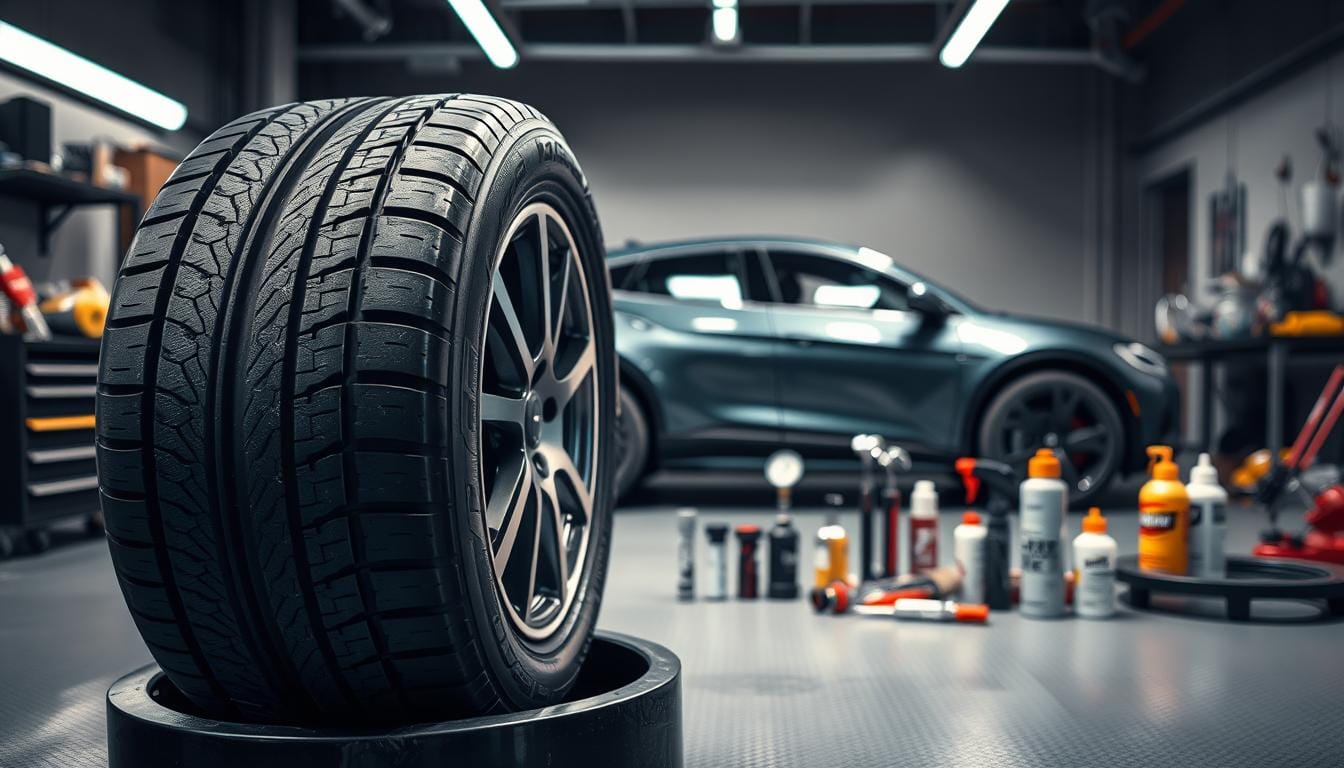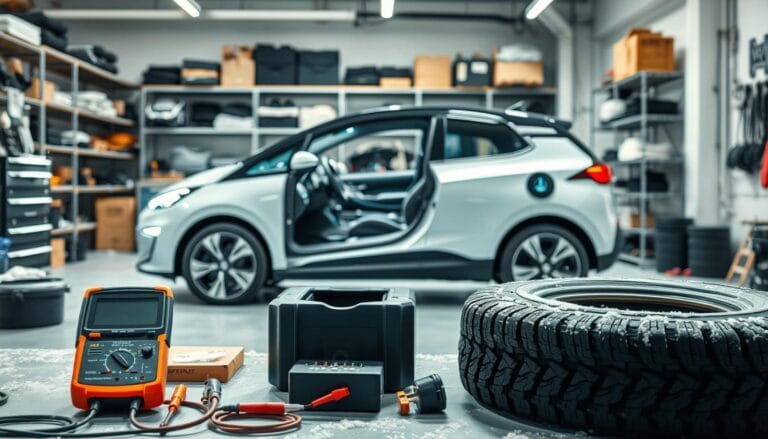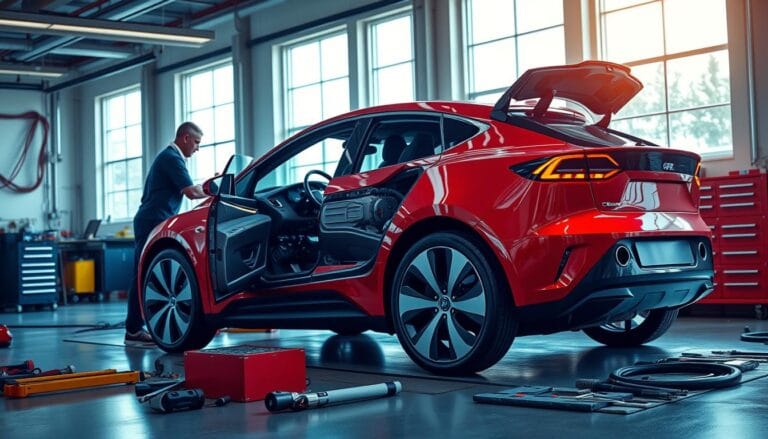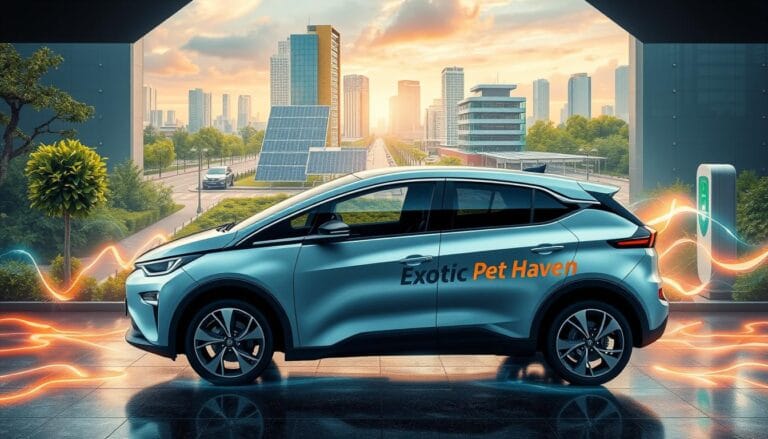EV Tire Maintenance: How to Maximize Range and Wear
Driving an electric vehicle is exciting and innovative. But, it also brings unique challenges for tire care. Your EV’s performance greatly depends on how well you maintain its tires. Electric vehicles are much heavier than regular cars, with batteries weighing up to 1,000 pounds. This can make tires wear out much faster.
Unlike regular cars, EVs have instant torque, which puts extra stress on tires. This strong acceleration can make tires wear up to 20% faster. It’s important to understand these factors for EV tire maintenance and to get the best performance from your vehicle.
Proper EV tire maintenance is not just about making tires last longer. It’s also about ensuring safe and efficient driving. The right care can help extend tire life and keep your EV performing well in different driving conditions.
Table of Contents
Understanding the Importance of Tire Maintenance
Electric vehicle owners need to focus on EV tire maintenance to get the best out of their cars. Tires are key to your EV’s performance, affecting its range, energy use, and how it drives.
Because EVs are heavier due to their batteries, tire wear is more of an issue. This affects how the car handles and moves.
Why Tire Maintenance Matters for EVs
Keeping your EV’s tires in good shape has many benefits:
- It cuts down on energy use
- It helps your car go further on a charge
- It makes your EV perform better
- It stops tires from wearing out too soon
How Tires Affect Range and Performance
Choosing the right tires can make a big difference in your EV’s performance. If your tires are not the right pressure, they work harder. This means your car uses more energy and goes less far on a charge.
| Tire Condition | Impact on EV Performance |
|---|---|
| Properly Inflated | Maximized range, optimal efficiency |
| Underinflated | Reduced range, increased energy consumption |
| Worn Tread | Decreased traction, possible safety risks |
Studies show EV drivers can save about $949 a year on maintenance by taking care of their tires. By checking tire pressure, rotating tires, and choosing EV-specific tires, you can make your car last longer and perform better.
Key Differences Between EV and Traditional Tires
Electric vehicle tires are a big step forward in car design. They are made to work well with electric cars, focusing on how they perform, save energy, and last long. Electric vehicle tires are different from regular tires.
Electric Vehicle Tires are made to meet electric cars’ special needs. They have:
- Reinforced sidewalls to handle extra battery weight
- Advanced rubber compounds for better durability
- Special tread patterns to handle quick torque
- More load-bearing power
Tire Construction Variances
Low Rolling Resistance Tires are key for electric cars to go further. These tires help save energy while moving. This makes driving more efficient.
| Tire Characteristic | Traditional Tires | EV Tires |
|---|---|---|
| Weight Support | Standard Load Capacity | Enhanced Load Capacity |
| Torque Handling | Regular Acceleration | Instant High Torque |
| Rolling Resistance | Standard | Minimized |
Recommended Tire Types for EVs
When picking tires for your electric car, look for Low Rolling Resistance Tires. Brands like Bridgestone and Goodyear make EV tires. They come with warranties up to 50,000 miles, ensuring your car performs well and lasts long.
Electric vehicle tires are not just a component, but a critical technology that directly impacts your vehicle’s efficiency and range.
Assessing Your EV Tires
Keeping your electric vehicle tires in good shape is key. EV Tire Maintenance is vital for top performance and longer tire life. It’s all about how your vehicle interacts with the road.
Regular checks can spot issues early. Electric Vehicle Tires wear differently because of their unique power and weight.
Visual Inspection Techniques
Here’s how to check your EV tires:
- Check tire sidewalls for any visible cracks or damage
- Look for uneven wear across the tire surface
- Inspect tread depth using the penny test
- Examine tire pressure and alignment
Checking for Uneven Wear Patterns
Uneven wear can mean big problems for your electric vehicle. Watch out for these signs:
| Wear Pattern | Potential Cause | Recommended Action |
|---|---|---|
| Center Strip Wear | Over-inflation | Adjust tire pressure |
| Outer Edge Wear | Under-inflation | Check and correct pressure |
| Diagonal Wear | Misalignment | Professional wheel alignment |
For EV owners, proactive tire maintenance is a smart move. It saves money and boosts your vehicle’s performance. Regular checks prevent sudden tire failures and keep your electric vehicle running smoothly.
Proper Inflation for Optimal Performance
Keeping the right EV tire pressure is key for your electric vehicle’s range and efficiency. It might seem small, but it’s vital for your car’s performance and energy use.
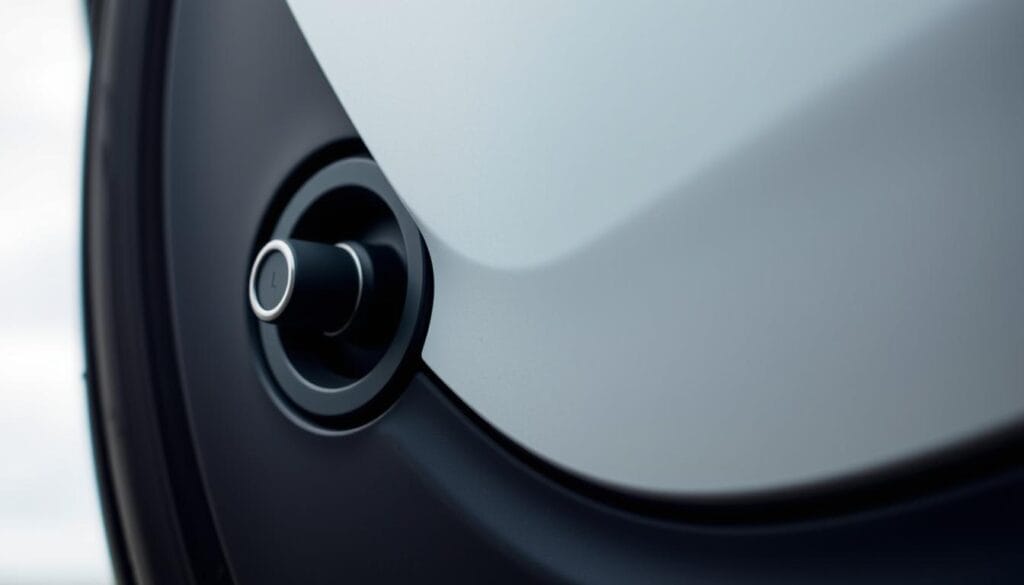
Proper tire inflation affects many parts of your electric vehicle’s performance. Energy-efficient tires need regular checks to work their best. Remember, tires lose air pressure over time – about 1 psi every month.
Recommended Tire Pressure Guidelines
Following the manufacturer’s advice is essential for your EV’s performance. Here are important tips for managing tire pressure:
- Check tire pressure monthly
- Verify pressure when tires are cold
- Use the vehicle’s recommended PSI
- Invest in a reliable tire pressure gauge
Consequences of Improper Inflation
“Tire pressure isn’t just about comfort – it’s about efficiency and safety.” – EV Performance Expert
Incorrect tire inflation can cause big problems:
| Inflation Status | Performance Impact |
|---|---|
| Underinflation | Increased rolling resistance, reduced range, accelerated tire wear |
| Overinflation | Uneven tire wear, reduced traction, compromised ride comfort |
Pro tip: Proper tire inflation can boost your electric vehicle’s range by up to 3%. Regular checks are a simple yet effective way to improve efficiency.
Rotating Your Tires: Best Practices
Electric vehicle tires need special care to work their best. Rotating EV tires is key to even wear and longer life.
Knowing how EVs wear tires is important. EVs have instant torque and heavy batteries. This can wear tires faster and unevenly than regular cars.
Recommended Rotation Frequency
Experts say to rotate EV tires every 5,000 to 7,500 miles. This keeps your car running well and tires lasting longer. Here are some tips:
- Check what the maker says about rotation times
- Look at tires during each rotation for uneven wear
- Do tire pressure checks with each rotation
Rotation Patterns for EV Tires
Each drivetrain needs its own rotation pattern for best tire life and performance:
| Drivetrain | Recommended Rotation Pattern |
|---|---|
| Front-Wheel Drive | Forward Cross Pattern |
| Rear-Wheel Drive | Rearward Cross Pattern |
| All-Wheel Drive | X-Pattern Rotation |
*”Proper tire rotation is not just maintenance—it’s an investment in your electric vehicle’s performance and safety.”*
By following these EV tire rotation tips, you can boost your car’s range, handling, and tire life.
Understanding Tread Depth
Tread depth is key for EV tire care and safety. For electric vehicle owners, checking tire tread is vital. It ensures your EV runs well and safely.
Checking your EV’s tires is important for safety and performance. Different things can wear down tires. Knowing when to replace them is key to avoiding risks.
Measuring Tread Depth Effectively
There are several ways to check your tire’s tread depth:
- Professional tire gauge measurement
- Penny test method
- Tread wear indicator bars
A professional tire gauge gives the most accurate reading. The penny test works by inserting a penny into the tread. If Lincoln’s head is visible, it’s time to replace the tires.
When to Replace Tires Based on Tread
Knowing when to replace EV tires is important. Michelin and others have guidelines for tread depth:
| Tread Depth | Recommended Action |
|---|---|
| 6/32 inch | Good for three seasons |
| 4/32 inch | Consider replacement soon |
| 2/32 inch | Legally considered bald |
Eco-friendly EV tires have special tread compounds for longer life. Regular checks keep your EV running well and safe on all roads.
Environmental Factors and Tire Wear
Electric vehicle tires face unique challenges from environmental conditions. These can greatly affect their performance and how long they last. It’s important to know how climate and terrain impact your Energy-Efficient Tires to keep your vehicle running well.
Different environments bring their own challenges for Electric Vehicle Tires. Temperature extremes can greatly affect how well tires perform and how fast they wear out. Studies show that BEVs are about 20% heavier than similar vehicles with internal combustion engines. This extra weight puts more stress on the tires.
Climate Considerations for Tire Longevity
Your tire’s lifespan is influenced by several environmental factors:
- Extreme heat can make rubber break down faster
- Cold temperatures can lower tire pressure and make them less flexible
- Humidity levels can affect how well the tire compound works
“Tire maintenance is not just about preservation, but about optimizing your electric vehicle’s overall efficiency.”
Effects of Terrain on Tire Performance
Different terrains can cause unique wear patterns on Energy-Efficient Tires. Driving in the city with lots of stops and starts is different from driving on smooth highways. BEVs also release more tire particles because they are heavier – about 26% more than hybrid vehicles.
Key terrain considerations include:
- Rough road surfaces can wear out tires faster
- Mountainous regions put extra stress on tires
- Changing road temperatures can affect tire performance
By understanding these environmental impacts, you can make your Electric Vehicle Tires last longer. This helps keep your vehicle running efficiently.
Seasonal Tire Maintenance Tips
Seasonal changes can greatly affect your electric vehicle’s tire performance and efficiency. It’s important to maintain your EV tires as temperatures change. This affects both tire condition and battery range.
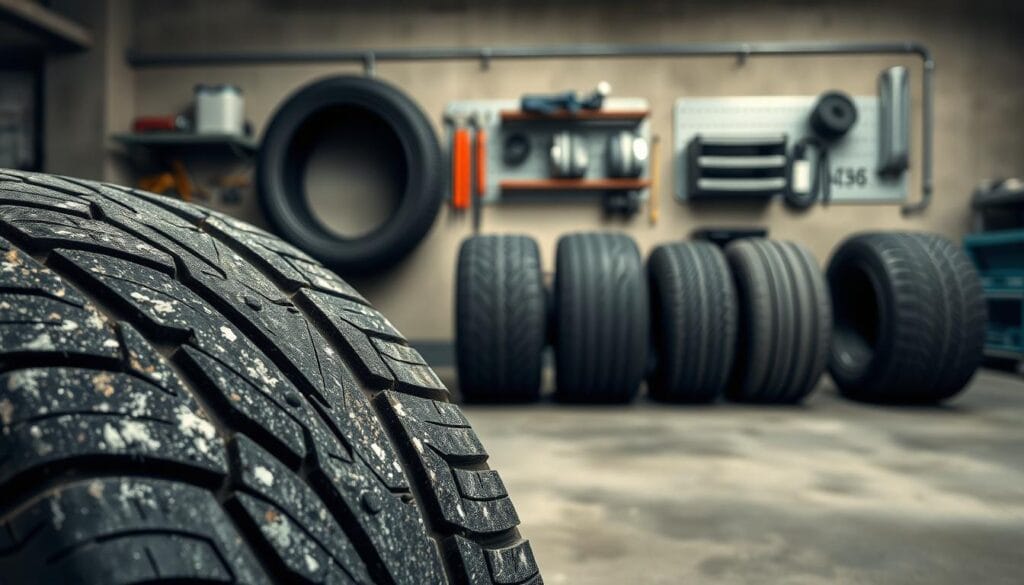
Electric vehicles need special care during seasonal changes. Cold weather can cut down your driving range. This is because cold temperatures slow down the chemical reactions in lithium-ion batteries.
Preparing for Winter Driving Conditions
Winter brings unique needs for EV tire maintenance:
- Install winter tires made for electric vehicles
- Check tire pressure more often in cold weather
- Make sure all-wheel drive EVs have snow tires on all four wheels
- Watch the tire tread depth (it should be at least 4/32 inch)
“Proper tire preparation is key to maintaining your EV’s performance in harsh winter conditions.”
Transitioning to Summer Tires
When it gets warmer, get your eco-friendly tires ready for the best performance:
- Rotate tires to ensure even wear
- Look for any winter damage
- Check tire pressure and alignment
- Think about using low rolling resistance tires for better range
Investing in EV tires can boost your vehicle’s efficiency. Brands like Goodyear and Michelin offer tires made for electric vehicles. They improve range and performance in different seasons.
Common Tire Issues and Solutions
Electric vehicle tires have special challenges because EVs are heavier and need specific tires. Knowing how to fix common tire problems is key to keeping your car safe and running well.
EV owners need to watch their tires closely. Electric Vehicle Tires are different, and small problems can make a big difference in how you drive.
Punctures and Repairs
Not all tire punctures can be fixed. Here’s what to do:
- Punctures smaller than 1/4 inch can often be professionally repaired
- Avoid DIY repairs that might compromise tire integrity
- Check puncture location – sidewall and shoulder damages typically require full tire replacement
*Safety first: When in doubt, consult a professional EV tire specialist.*
Dealing with Sidewall Damage
Sidewall damage is a big deal for EV tire replacement. EVs are much heavier because of their batteries, often 40% heavier than cars with gas engines.
- Inspect sidewalls regularly for cuts, bulges, or deformations
- Any visible sidewall damage requires immediate tire replacement
- Specialized EV tires have reinforced sidewalls to support extra vehicle weight
EV tires usually last between 30,000 to 40,000 miles. Regular checks and care can help them last longer and keep your car running great.
Technology Aiding EV Tire Maintenance
Modern electric vehicles (EVs) use advanced tire technologies for better performance and efficiency. Low rolling resistance tires are key in EV maintenance. They help drivers get the most out of their vehicle’s range and battery life. Brands like Sailun and Bridgestone are leading in creating special tire solutions for EVs.
Tire Pressure Monitoring Systems (TPMS) are a big step forward in EV care. They send alerts about tire pressure in real-time. This helps avoid problems that could affect your car’s performance. EV tires from Hankook, for example, use new materials to boost battery range and cut down on wear.
New tech is changing how EV tires are made. The Sailun ERange and Bridgestone Turanza EV tires use special rubber to lower rolling resistance. This is important because EV tires wear out faster than regular tires due to their weight and the torque they handle.
The EV market is getting bigger, and so is the tech behind EV tires. These advancements help with noise, energy use, and more. Keeping up with these changes can help you make your EV run better and last longer.

